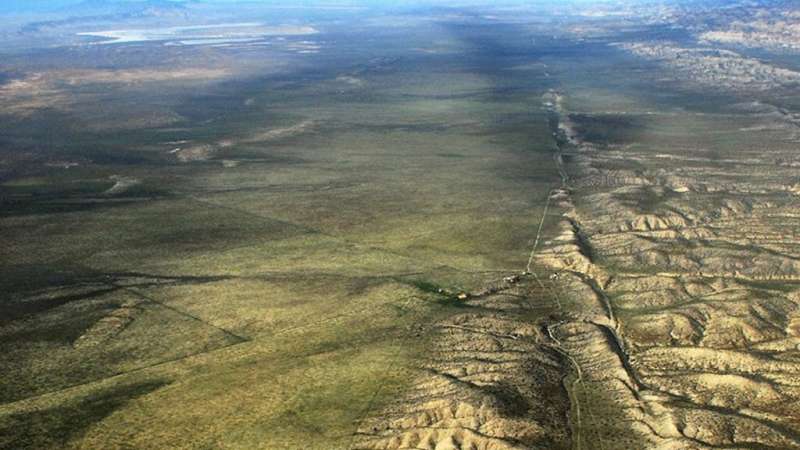How land deformation occurs when fault sections creep
Strike-slip faults can be fickle about their movement—they can move slow and steady or remain stationary until their built-up stress is let loose in one go. But how do these faults’ movements change from a locked and sudden release to a steady creep? And how does this change affect the rocks around the fault? Understanding where these deformation styles occur and the variables that contribute to the kind of movement is important in determining earthquake hazards.
To uncover what happens near a change in slip, Ross et al. created a physical model to isolate slip behavior along a strike-slip structure. They used deforming silicone as an analog for Earth’s crust, which allowed them to disregard other variables that can influence slip types, including lithology differences, deformation history, and fault geometry.
One side of the experiment remained stationary while the other side moved, and along that boundary between the two sides, one portion was stuck to itself, or locked, while another was cut to simulate creeping. Colored sand grains were sprinkled on the surface to track motions. Top-down time-lapse photography captured 2D deformation, whereas 3D deformation was tracked with photogrammetry.
They found that contraction develops where the creeping portion of the fault runs into the locked section of the fault. Simultaneously, extension occurs on the opposite side of the fault as the creeping section pulls away from the locked section. This pattern repeats in secondary locations, creating an alternating pattern of extension and contraction. These zones have opposite vertical motions, creating topographic highs and lows.
When the researchers compared their model to field data on the San Andreas Fault in central California, they found that both model and field data showed a pattern of alternating extension and contraction across the creeping fault sections. According to the authors, this work shows that a change in slip behavior can lead to off-fault deformation and could explain some of the patterns seen along the San Andreas Fault.
Novel numerical model simulates folding in Earth’s crust throughout the earthquake cycle
Emily O. Ross et al, Relating Slip Behavior to Off‐Fault Deformation Using Physical Models, Geophysical Research Letters (2022). DOI: 10.1029/2021GL096784
This story is republished courtesy of Eos, hosted by the American Geophysical Union. Read the original storyhere.
Citation:
How land deformation occurs when fault sections creep (2022, July 5)
retrieved 5 July 2022
from https://phys.org/news/2022-07-deformation-fault-sections.html
This document is subject to copyright. Apart from any fair dealing for the purpose of private study or research, no
part may be reproduced without the written permission. The content is provided for information purposes only.

Strike-slip faults can be fickle about their movement—they can move slow and steady or remain stationary until their built-up stress is let loose in one go. But how do these faults’ movements change from a locked and sudden release to a steady creep? And how does this change affect the rocks around the fault? Understanding where these deformation styles occur and the variables that contribute to the kind of movement is important in determining earthquake hazards.
To uncover what happens near a change in slip, Ross et al. created a physical model to isolate slip behavior along a strike-slip structure. They used deforming silicone as an analog for Earth’s crust, which allowed them to disregard other variables that can influence slip types, including lithology differences, deformation history, and fault geometry.
One side of the experiment remained stationary while the other side moved, and along that boundary between the two sides, one portion was stuck to itself, or locked, while another was cut to simulate creeping. Colored sand grains were sprinkled on the surface to track motions. Top-down time-lapse photography captured 2D deformation, whereas 3D deformation was tracked with photogrammetry.
They found that contraction develops where the creeping portion of the fault runs into the locked section of the fault. Simultaneously, extension occurs on the opposite side of the fault as the creeping section pulls away from the locked section. This pattern repeats in secondary locations, creating an alternating pattern of extension and contraction. These zones have opposite vertical motions, creating topographic highs and lows.
When the researchers compared their model to field data on the San Andreas Fault in central California, they found that both model and field data showed a pattern of alternating extension and contraction across the creeping fault sections. According to the authors, this work shows that a change in slip behavior can lead to off-fault deformation and could explain some of the patterns seen along the San Andreas Fault.
Novel numerical model simulates folding in Earth’s crust throughout the earthquake cycle
Emily O. Ross et al, Relating Slip Behavior to Off‐Fault Deformation Using Physical Models, Geophysical Research Letters (2022). DOI: 10.1029/2021GL096784
This story is republished courtesy of Eos, hosted by the American Geophysical Union. Read the original storyhere.
Citation:
How land deformation occurs when fault sections creep (2022, July 5)
retrieved 5 July 2022
from https://phys.org/news/2022-07-deformation-fault-sections.html
This document is subject to copyright. Apart from any fair dealing for the purpose of private study or research, no
part may be reproduced without the written permission. The content is provided for information purposes only.
